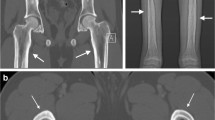Abstract
Several studies using op/op mice have shown that macrophage colony-stimulating factor (M-CSF) was necessary for osteoclast formation in vivo. Previously we reported that osteoblastic cells produced two molecular forms of M-CSF; one is an 85-kDa M-CSF, and the other is a proteoglycan form of M-CSF (PG-M-CSF) which has a binding affinity for bone-derived collagens and is extractable from human bone. In this study, we performed immunostaining of human bone using a newly established anti-PG-M-CSF antibody, and showed positive staining PG-M-CSF, probably produced by bone lining cells, on the bone surface. This observation suggests that the bone surface is suitable for osteoclast formation because of the presence of PG-M-CSF.
Similar content being viewed by others
References
Takahashi N, Udagawa N, Akatsu T, Tanaka H, Isogai Y, Suda T (1991) Deficiency of osteoclasts in osteopetrotic mice is due to a defect in the local microenvironment provided by osteoblastic cells. Endocrinology 128:1792–1796
Kodama H, Nose M, Niida S, Yamasaki A (1991) Essential role of macrophage colony-stimulating factor in the osteoclast differentiation supported by stronal cells. J Exp Med 173:1291–1294
Felix R, Cecchini MG, Hofstetter W, Elford PR, Stutzer A, Fleisch H (1990) Impairment of macrophage colony-stimulating factor production and lack of resident bone marrow macrophages in the osteopetrotic op/op mouse. J Bone Miner Res 5:781–789
Wiktor-Jedrzejczak W, Bartocci A, Ferrante AW, Ahmed-Ansari A, Sell KW, Pollard JW, Stanley ER (1990) Total absence of colony-stimulating factor 1 in the macrophage-deficient osteopetrotic (op/op) mouse. Proc Natl Acad Sci USA 87:4828–4832
Kodama H, Yamasaki A, Nose M, Niida S, Ohgame Y, Abe M, Kumegawa M, Suda T (1991) Congenital osteoclast deficiency in osteopetrotic (op/op) mice is cured by injection of macrophage colony-stimulating factor. J Exp Med 173:269–272
Wiktor-Jedrzejczak W, Urbanowska E, Aukerman SL, Pollard JW, Stanley ER, Ralph P, Ansari AA, Sell KW, Szperl M (1991) Correction by CSF-1 of defects in the osteopetrotic op/op mouse suggests local, developmental, and humoral requirements for this growth factor. Exp Hematol 19:1049–1054
Tanaka S, Takahashi N, Udagawa N, Tamura T, Akatsu T, Stanley ER, Kurokawa T, Suda T (1993) Macrophage colonystimulating factor is indispensable for both proliferation and differentiation of osteoclast progenitors. J Clin Invest 91:257–263
Motoyoshi K, Takaku F, Mizoguchi H, Miura Y (1978) Purification and some properties of colony-stimulating factor from normal human urine. Blood 52:1012–1020
Wong GG, Temple PA, Leary AC, Witek-Gianotti JS, Yang YC, Ciarletta AR, Chung M, Murtha P, Kirz R, Kaufmann RJ, Ferenz CR, Sibley BS, Turner KJ, Hewick RM, Clark SC, Yanai N, Yokota H, Yamada M, Saito M, Motoyoshi K, Takaku F (1987) Human CSF-1: molecular cloning and expression of 4-kb cDNA encoding the human urinary protein. Science 235:1504–1506
Suzu S, Ohtsuki T, Yanai N, Takatsu Z, Kawashima T, Takaku F, Nagata N, Motoyoshi K (1992) Identification of a high molecular weight macrophage colony-stimulating factor as a glycosaminoglycan-containing species. J Biol Chem 267:4345–4348
Ohtsuki T, Suzu S, Nagata N, Motoyoshi K (1992) A human osteoblastic cell line, MG-63, produces two molecular types of macrophage colony-stimulating factor. Biochim Biophys Acta 1136:297–301
Ohtsuki T, Hatake K, Suzu S, Harigaya K, Miura Y, Motoyoshi K (1994) Alteration of the proteoglycan form of macrophage colony-stimulating factor produced by a human stromal line stimulated by tumor necrosis factor-α. Exp Hematol 22:366–369
Suzu S, Yanai N, Sato-Somoto Y, Yamada M, Kawashima T, Hanamura T, Nagata N, Takaku F, Motoyoshi K (1991) Characterization of macrophage colony-stimulating factor in body fluids by immunoblot analysis. Blood 77:2160–2165
Suzu S, Ohtsuki T, Makishima M, Yanai N, Kawashima T, Nagata N, Motoyoshi K (1992) Biological activity of a proteoglycan form of macrophage colony-stimulating factor and its binding to type V collagen. J Biol Chem 267:16812–16815
Ohtsuki T, Suzu S, Hatake K, Nagata N, Miura Y, Motoyoshi K (1993) A proteoglycan form of macrophage colony-stimulating factor that binds to bone-derived collagens and can be extracted from bone matrix. Biochem Biophys Res Comm 190:215–222
Hanamura T, Motoyoshi K, Yoshida K, Saito M, Miura Y, Kawashima T, Nishida M, Takaku F (1988) Quantitation and identification of human monocytic colony-stimulating factor in human serum by enzyme-linked immunosorbent assay. Blood 72:886–892
Udagawa N, Takahashi N, Akatsu T, Tanaka H, Sasaki T, Nishijima T, Koga T, Martin TJ, Suda T (1990) Origin of osteoclasts: mature monocytes and macrophages are capable of differentiating into osteoclasts under a suitable microenvironment prepared by bone marrow-derived stromal cells. Proc Natl Acad Sci USA 87:7260–7264
Takahashi N, Akatsu T, Udagawa N, Sasaki T, Yamaguchi A, Moseley JM, Martin TJ, Suda T (1988) Osteoblastic cells are involved in osteoclast formation. Endocrinology 123:2600–2602
Kimura F, Suzu S, Nakamura Y, Wakimoto N, Kanatani Y, Yanai N, Nagata N, Motoyoshi K (1994) Structural analysis of proteoglycan macrophage colony-stimulating factor. J Biol Chem 269:19751–19756
Rhodes RK, Miller EJ (1978) Physicochemical characterization and molecular organization of the collagen A and B chains. Biochemistry 17:3442–3448
Baron R, Neff L, Van PT, Nefussi J-R, Vignery A (1986) Kinetic and cytochemical identification of osteoclast precursors and their differentiation into multinucleated osteoclasts. Am J Pathol 122:363–378
Ueda Y, Nakanishi I (1989) Immunohistochemical and biochemical studies on the collagenous proteins of human osteosarcomas. Virchows Arch [B] 58:79–88
Suzu S, Kimura F, Yamada M, Yanai N, Kawashima T, Nagata N, Motoyoshi K (1994) Direct interaction of proteoglycan macrophage colony-stimulating factor and basic fibroblast growth factor. Blood 83:3113–3119
McCarthy T, Centrella M, Fox G, Arakawa T, Canalis E (1987) Endothelial cell growth factor (ECGF) and basic fibroblast growth factor (bFGF) independently regulate bone cell replication and type I collagen transcription and translation (abstract). J Bone Miner Res 2 (suppl 1):252
Mayahara H, Ito T, Nagai H, Miyaiima H, Tsukuda R, Taketomi S, Mizoguchi J, Kato K (1993) In vivo stimulation of endosteal bone formation by basic fibroblast growth factor in rats. Growth Factors 9:73–80
Author information
Authors and Affiliations
Rights and permissions
About this article
Cite this article
Ohtsuki, T., Hatake, K., Suzu, S. et al. Immunohistochemical identification of proteoglycan form of macrophage colony-stimulating factor on bone surface. Calcif Tissue Int 57, 213–217 (1995). https://doi.org/10.1007/BF00310261
Received:
Accepted:
Issue Date:
DOI: https://doi.org/10.1007/BF00310261




